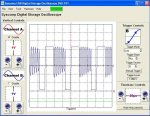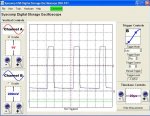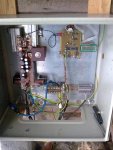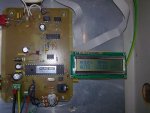some typical waveforms
I have attached some typical waveforms to expect from say a buck converter, that I have measured from one of my converters. One is the voltage on the drain wrt the source, and a second is the voltage on the mosfet gate wrt the source. There is ringing from the inductor that appears on the drain. The inductor has a resistance of about 10milliohms, and is good for 1000W. approx 20A@50V.
The waveforms are sharp, and this leads to high converter efficiency, as there is low tri-state conduction in the device. It is essential to have good supply bypassing, for the expected frequencies.
The gate was driven with a 10V rail, and the probe was X10.
there was approx 52V supply at the time. the switching speed was 16.67kHz.
This converter is used as a windmill MPPT at the moment.
Gordon.
PS: there is no resistor in the mosfet gate drive.
I have attached some typical waveforms to expect from say a buck converter, that I have measured from one of my converters. One is the voltage on the drain wrt the source, and a second is the voltage on the mosfet gate wrt the source. There is ringing from the inductor that appears on the drain. The inductor has a resistance of about 10milliohms, and is good for 1000W. approx 20A@50V.
The waveforms are sharp, and this leads to high converter efficiency, as there is low tri-state conduction in the device. It is essential to have good supply bypassing, for the expected frequencies.
The gate was driven with a 10V rail, and the probe was X10.
there was approx 52V supply at the time. the switching speed was 16.67kHz.
This converter is used as a windmill MPPT at the moment.
Gordon.
PS: there is no resistor in the mosfet gate drive.
Attachments
-
91.1 KB Views: 66
-
84.6 KB Views: 57
Last edited:




